#Rebuild of Evangelion 2.0: Rei & Shinji's Connection
Explore tagged Tumblr posts
Text
SiNoMC: for the Love of Rei
post migrated to pillowfort (March 2024) archive: dashboard | blog [removed non-image content for reasons]


[IMAGE DESCRIPTIONS]
1ST IMAGE...
Rei sits with her back diagonally to the viewer on a foldable chair in her 1 bedroom home dressed in school clothes and looking down at something in front of her. A single light source coming from the crack between the long window curtains to her left shines a streak of blue directly infront of her and into her otherwise purple dark room. In the room is what appears to be: 1) a mini fridge (with freezer) diagonally to the front right of her, 2) an open box on the floor to the left of it with bandages sticking out, 3) a satchel hanging from the right side of the fridge, 4) various things sitting ontop of the fridge, 5) a roll top dresser with two books ontop in the corner to her diagonal front left, 6) a partially made bed diagonally to the rear left of her on a low metal bedframe, 7) a wide lamp attached to the “headboard” side of said bedframe, 8) a few articles of clothing on the floor diagonally to her rear right, and 9) an open doorway to her far right. The bedroom wall in front of her is composed of large squares that’re almost a third of her height each and reminiscent of padding.
2ND IMAGE...
Rei (left) and Shinji (right) stand around 2 feet apart on a metal platform in front of a cylindrical tank of small fish. They both wear all-white clothes: Rei a knee-high skirt, Shinji ankle-long pants, both matching closed toe sandals. The image stops just below their buttocks, showing the underside of Shinji’s fingers.
[END IMAGE DESCRIPTIONS]
#Shit i Needed off My Chest#long post#Rei (NGE) is bestgirl#anime#evangelion#rebuild of evangelion#Rei Ayanami#Shinji Ikari#waifus#serious discourse#Evangelion 2.0 Elevator Scene (Amazon Prime dub)#Rebuild of Evangelion 2.0: Rei & Shinji's Connection#YouTube#this write-up didn’t have space for certain matters#like the “no personality” debate#or the other matter#ya know…#what guys really want in a woman?#someone who will protect ‘em
5 notes
·
View notes
Text

the seventh angel is one of the angels in the rebuilds that doesn't resemble any angel from the original anime. dubbed "clockiel" by some fans, this angel appears as a giant clockwork mechanical angel with two long legs, a swinging pendulum that houses it's core, and Sachiel-like heads that move much like clock hands. it attacks by shooting large cross shaped explosions. because of its massive size, Unit 02 must be equipped with flight capabilities and a magnetic crossbow in order to defeat it.
https://wiki.evageeks.org/Seventh_Angel
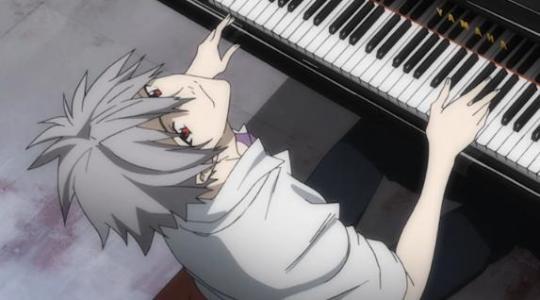
Kaworu Nagisa is very similar to Rei, in the fact that he is a seed of life inhabiting a human body. while Rei is from Lilith, Kaworu is from Adam. despite his human form, he doesn't consider himself to be human. he also frequently refers to humans as "Lilin". he was secretly sent by SEELE to reach Adam and cause the third impact, but NERV was told that he would be a replacement pilot for unit 02. he immediately achieved perfect sync rates during his first test. despite being sent to destroy humanity, he takes an interest in them and their loneliness, especially Shinji. Kaworu takes great interest in Shinji, which initially makes Shinji uncomfortable as he has trouble trusting or emotionally connecting with people, but eventually they become close. later Kaworu takes control of unit 02 and descends to central dogma containing the body of Lilith. as he fights with Shinji, Shinji is emotional distraught and says that Kaworu betrayed him just as Gendo had. Kaworu then begs for Shinji to kill him, which he does reluctantly. in end of evangelion, he is part of the massive Rei/Lilith/Adam being, and appears to help calm Shinji and bring down his AT field.
in the rebuilds, he appears on the moon during the construction of Eva-06 before becoming it's pilot in 2.0. he, inside 06, stops Eva-01 from activating the third impact. post time skip, he plays a much larger role. as Shinji reaches the now nearly destroyed NERV hq, he meets Kaworu he teaches him to play the piano, and the two become very close. Kaworu shows him the ruins of the near third impact, and Shinji is distraught saying that he only wanted to save Rei, but Kaworu says that humanity does not see it that way. Kaworu tells him that they can save the world again by pulling the spears of longinus and cassius from Mark.06. he then takes Shinji's choker and claims that he will bare the wait of Shinji's punishment. as they descend and during the battle, Kaworu notices that something is wrong, and begs Shinji not to pull the spears. but Shinji doesn't listen and the twelfth angel is released. because of this, Kaworu becomes the thirteen angel. unit 13 then begins to awaken as the forth impact starts. Kaworu apologizes to Shinji and says that it was his own fault. he says that they will meet again before the choker explodes and decapitates him. although Mari manages to eject Shinji, he is absolutely fucking traumatized. during the additional impact in 3.0+1.0, Kaworu appears as a vision and explains that he has written Shinji's name in the book of life, which allows them to meet in all cycles after every time the universe is reset. after the would is rebuilt again without evangelions ever existing, Kaworu is seen as an adult, alongside the other children now also adults.
https://wiki.evageeks.org/Kaworu_Nagisa
32 notes
·
View notes
Photo


admittedly a little fascinated by the theme of food that persists across evangelion rebuilds. a homecooked meal that you share with your loved ones as something that can bring people together (pretty prominently in 2.0 and later as well, like in the 3.0+1.0 village) versus the sterile paste shinji gets delivered to his isolated room at nerv via a chute in 3.0 (left image) ... in 3.0+1.0 (right image) you see the people at wille have similar rations, but they have little touches like real fresh oranges, cucumbers, rice, quite possibly from the farms of the community of survivors wille’s been providing with resources (you see q rei in that community planting rice). wille isn’t giving supplies to that community because they necessarily want anything in return, iirc, but because their families are down there, there are people down there living in the aftermath of the apocalypse. food like this is said to be scarce & is hard enough to come by in this barren world. yet they share it. people and food and connection and hope in the face of loneliness, it’s a little sweet
30 notes
·
View notes
Text
Short Reflection: Evangelion 2.0- You Can (Not) Advance
When I first re-watched the original Neon Genesis Evangelion years ago, I broke its structure down into four parts. Part 1, spanning episodes 1 through 6, is an introduction to a broken, vicious world, showing Shinji at his lowest as he’s thrust into violence beyond his capabilities and somehow manages to seize onto personal connections despite the hell around him. Part 2, spanning episodes 7 to 13 or thereabouts, is episodic downtime that lets the characters develop positively, investing you in their struggles by showing their daily lives amidst the angel assault. Part 3, episodes 14 through 19, is a slow descent right back into hell, as the post installed by the previous episodes is ripped away one piece at a time until Shinji and his Eva literally reject humanity and return to monke. And Part 4, lasting from episode 20 until the end, is the dissolution, where production hell breaks both the characters and the show itself down to their component parts for an increasingly surreal, philosophically-driven finale. It’s a really beautiful structure, and ever since I picked up on it, it’s informed so much of my understanding of Evangelion. And I suspect Anno himself is at least somewhat aware of it, because he’s brought it back for first two Rebuild movies... for better and worse.
See, while Rebuild 2.0 definitely starts pushing the newness of this new take on Evangelion to the forefront, it’s still very much within that framework I just talking about. Rebuild 1.0 was, of course, a near shot-for-shot recreation of Part 1, recreating the first six episodes with a slavish attention to detail and only a few key changes. 2.0, meanwhile, is a remix of Parts 2 and 3, covering everything from Asuka’s introduction to episode 19′s legendary climax. It’s almost perfectly bisected, honestly. The movie’s first half is mostly about Asuka, Rei and Shinji hanging out and fighting random angels, as well as giving the story’s school side the focus it sorely lacked in the first movie (which I very much appreciated; Toji and Kensuke finally get to be actual characters again! Huzzah!). Then we hit the “episode break” at the midpoint, and the second half turns its attention to the emotionally devastating backslide into despair with Unit 03 going berserk and the tape angel’s descent into the geofront. Obviously, with thirteen episodes worth of material to go through, there are far more cuts and changes to make it all fit, even before we get to the outright new stuff that the Rebuilds are playing with. But structurally speaking, 2.0 accomplishes the same goal as the TV show’s middle half: allow the characters time to relax and develop and achieve some degree of hope, then sit back and laugh as it all comes tumbling down, tumbling down.
And to the movie’s credit, it mostly makes this condensed structure work. There are still a few shots and sequences directly ripped from the show, but for the most part, it relies on new or re-adjusted scenes to communicate the same emotional points as the show without copying it outright. One of my favorite bits is when the gang visits an aquarium that’s designed to replicate how the ocean used to be before the Second Impact. Not only is it a great way to give the characters space to breath and hang out, it says so much about the state of the world, and the tragedy of what was lost when the angels descended. Even blue, fishy water is a relic of a bygone era, and these kids will never know what it was like to live in a world full of oceans that weren’t red and dying. The juxtaposition of those two sentiments- endearing character work and large-scale, primordial tragedy- is Evangelion at its best. This is what the Rebuilds should be: not just repeating what’s come before, but reinterpreting it in new forms without losing its emotional center. As much as I loved 1.0′s slavish recreation of the show, it’s great to see 2.0 really flex its muscles and offer its own point of view.
That said, there are some areas where I feel like this movie’s changes make it an overall weaker experience than the show. First, I feel like the characters are way too self-aware in this movie. So much of NGE’s drama came from the characters not understanding themselves, or understanding themselves but not being able to put that understanding into words, or struggling with how to even go about understanding themselves. The pain of what’s left unspoken, unprocessed, was crucial to that show’s success. Here, though, it feels like every character has a moment where they basically turn to the audience and say “Hey, this is my emotional baggage and here’s how I’m trying to deal with it.” Asuka tells Misato unprompted about her complex over being alone, Shinji explains the symbolic purpose of the Walkman he always carries with him, and even Rei, the least communicative character of all, is able to verbalize her situation. These don’t feel like conversations between emotionally stunted teenagers; they feel like Anno literally explaining himself to the audience because he’s tired of the point going over people’s heads. Which, you know, I can’t say I blame him for that instinct, but aside from Misato’s wrenching goodbye to Shinji when he leaves her apartment for the last time, these moments don’t pack nearly the same punch as all the times the characters talked around each other in the show.
Second, and most obvious: the fanservice. Now, I’m not gonna pretend the original NGE was some paragon of using sexuality in fiction. It had its fair share of sleazy camera angles and perverted situations, especially in the parts of the show this movie is most drawing from. But it also knew how to weaponize that sexualization, to twist in ways that forced the audience to confront the dark currents underpinning anime’s constant exploitation of the female body. That is not the case with 2.0. All the fanservice in this movie- and there’s quite a bit of it- seems to only exist to be fanservice, to give the audience something to leer at mindlessly at the expense of the female characters. There’s a scene from the show where Asuka falls asleep in Shinji’s bed, and the way the camera puts us in his eyes as he gazes at her defenseless body forces the audience to internalize just how fucking gross it is to ogle a teenage girl who’s nowhere near mature enough to even process her sexuality in a healthy manner. A remixed version of that scene exists in this movie, but instead of making a subversive point with the ogling camera angles, it just... has ogling camera angles. Why are we staring up the crotch of her panties as she rolls over? Just to stare up the crotch of her panties as she rolls over? Because if so, uh, you could not be missing the point harder if you tried.
And speaking of Asuka.
Look, there’s no way I can be fair about this. Asuka Langley Soryu is my favorite fictional character of all time, the character who speaks most directly to my own struggles and has had a genuine positive impact in my life. I care too much about her to discuss her with any kind of objectivity. But I really don’t like what this movie’s done to her. She’s turned into a fanservice pinup more times over the course of 2.0 than she was in the entirety of the original show. Worse still, her character’s been simplified to such a degree that she comes off as little more than a stereotypical tsundere. Violent with Shinji for no reason, dumbass accidental pervert scenarios, all abrasiveness all the time... where’s the zest for life? The enthusiasm? The sheer confidence and spitfire personality that made Asuka such an electrifying, human presence? Considering she has a different last name for some reason, she may well be an entirely different person, similar to the Asuka we know but more angry and bitter and closed-off. She even plays with a game console in her spare time, using technology to distract herself from her isolation much like Shinji does. But even if Asuka Shikinami is meant to be her own person with her own place in this story, the shadow of Asuka Soryu constantly hangs over her, making it impossible to ignore how little she measures up. This should be one of the best parts of Evangelion, and it just falls so fucking short.
Now, I’ve just complained for quite a few paragraphs. With so much negative to say, you might think I’m really down on 2.0 overall. But that’s actually not true. Because there’s one more part of this movie we have to talk about.
We have to talk about the ending.
The climax of Evangelion 2.0 is the moment the series truly comes into its own. It takes the same basic structure as episode 19: an Angel breaks into NERV headquarters as Shinji tries to run away, the other Evas are soundly defeated, and Shinji is forced to return and pilot Unit 01 for the sake of saving the people he cares about, unlocking beast mode at the last moment to achieve victory at the expense of something fundamental to his humanity. But instead of following those beats to the letter, 2.0 takes that framework and pushes it as far beyond its limits as it can possibly go. And as a result, what was already one of the series’ jaw-dropping moments becomes nothing short of astounding. The way it builds off what’s come before and yet breaks from it entirely, the way it raises the stakes to End of Evangelion levels, the way it uses the subtle changes the Rebuilds have been introducing to utterly flip the story on its head, the way it’s simultaneously a moment of extraordinary triumph and shocking personal failure... I’m still reeling from how extraordinary that was. And more importantly, it’s so thoroughly changed the story’s trajectory that the next movie has no choice but to fully leave the show behind. From this point on, the Rebuilds physically cannot just be a rehash of story beats from 20 years ago. They have to become their own thing, with new ideas, new arcs, new things to say and new ways to say them. This is the moment where Evangelion is truly born anew, and its baptism is as appropriately cataclysmic as I could possibly hope for.
From this point forward, we’re truly in uncharted waters. Neon Genesis Evangelion the show has been retold, cut short, and set down an entirely new path. It’s time to truly leave the past behind and see what’s waiting for us in the future. So despite all my frustrations with 2.0, it’s left me more hopeful than ever to see what the Rebuilds have in store. It’s bold enough to try new things, smart enough to mostly do them right, and exciting enough to keep my expectations sky-high for what comes next. For that, I give it a score of:
7.5/10
And lastly, a couple quick things I couldn’t fit in above:
-I don’t think using an insert song for the Eva 01 Dummy Plug Rampage scene was a good idea. It takes away from how fucking visceral and awful that moment should feel.
-Kaji and Misato’s romance... strangely works a lot better here? It cuts out all the moments where he’s being seriously creepy, so it’s a lot more palatable.
-Building the main emotional hook around Rei trying to reconcile Shinji and his father was a great idea and it works like gangbusters, especially when Gendo inevitably betrays Shinji’s trust and Shinji chooses to spite him for Rei’s sake.
-We’ve only had a few scenes with Mari, so I don’t know quite what to make of her yet. That said, something about her almost seems designed to, like... I don’t know, intentionally feel out of place and weirdly self-aware about the “point” of the story she’s in? Maybe??? I dunno, hopefully 3.0 gives her more time so I can start figuring her out.
That’s all for now. God, I’m excited for 3.0. See you next time!
#anime#the anime binge-watcher#tabw#evangelion#neon genesis evangelion#nge#eva#neon genesis evangelion rebuild#eva rebuild
14 notes
·
View notes
Text
SPOILER-FILLED REVIEW: Talking About That Evangelion 3.0+1.0 Ending

A note on safety: The following movie review undertook the strictest of safety procedures to watch the anime film in cinemas in Japan, including washing hands with disinfectant before and after, sitting in seats apart from others, going to a cinema outside of the busy metro area, and wearing a mask during the entire runtime of the movie. We strongly urge everyone to follow the recommended safety protocol in your country and always wear a mask when in public — not just for your sake, but everyone else’s as well.
For those who are outside of Japan and want to know how the latest (and final) Evangelion film stacks up, we have already published our completely spoiler-free review. For those that want to know more, please read on.
After the airing of the NHK documentary which followed Hideaki Anno and the four-year production of Evangelion: 3.0+1.0 Thrice Upon a Time, the unofficial “spoiler ban” was lifted by Studio Khara on March 22. This means, as much as Khara is concerned, we are free to discuss anything and everything Evangelion: 3.0+1.0, like how [omitted for spoilers] kills [spoilers] and LCL [spoilers].
Seriously though, if you don’t want to read any spoilers for Evangelion: 3.0+1.0, then leave. Immediately. Close the tab, don’t scroll down.
This is a warning.
I’m not kidding.

I’m putting an image here as a buffer. It's sweet right?
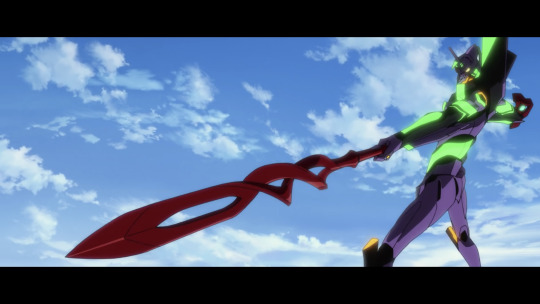
If you scroll past the next image you will be spoiled for everything in the film. This is your last warning.
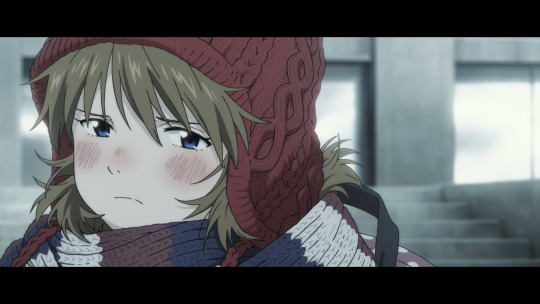
"Asuka" as a kid
Welcome to Evangelion: 3.0+1.0 Thrice Upon a Time where I may have lied in my previous review, cause things go tumbling down — but in a good way. You’ll have to forgive me if I don’t recall the exact right terminology here on out: between the Doors of Guf, the hundreds of Evangelion models and ships we see, and that ending, it’s hard to keep it all in one head. That’s why this film has four directors.
If you’re already here, you’ve probably read the synopsis going around the internet right now. Yes, it explains what happens on screen, but experiencing it is a different story. Evangelion 3.0+1.0 takes a lot of cues from The End of Evangelion in its final act, but prior to that it is mostly a story of growth for Shinji, where he rejects being depressed (after a heart to heart with black-suit Rei, who then turns into LCL), learns that things aren’t 100% his fault. Shinji goes on to tackle his source of depression head-on; owning up to his past mistakes and taking down his father, who is now literally just a vessel of his own desires.

Unholy Gendo
Something truly missing from Evangelion 3.0, and one of the reasons I loved Evangelion 2.22, was just the gang hanging out together and interacting with the — very scarred — world around them. That scar has vastly grown throughout the 14 years Shinji was missing from the actual 3rd impact (the one at the end of 2.22 was a “near-impact event”) which saw the world covered in the red haze we saw in 3.0. Luckily, WILLE has purification pods that keep the core-ification of the world at bay. We saw that being used in the 12-minute preview, but throughout the film, they’re used extensively to keep the Evangelion wandering the landscapes on the red earth away from the villages that are helping the WILLE cause. They need to get food from somewhere.
This is where we spend a lot of time learning how the characters from Shinji’s class all survived, got paired off, and that Asuka is staying (and is probably in love) with Kensuke. She confesses to Shinji that she loved him when they were kids, but 28-year-old Asuka can’t keep loving someone who hasn’t changed in 14 years. Shinji does accept the confession, saying to her that he loved her too, and she turns into LCL — though that’s in the Anti-Universe and after Asuka meets the “original” Asuka (I’ll get into that). As I said, it’s The End of Evangelion 2.0.
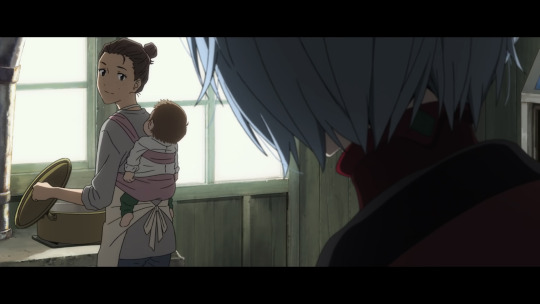
Rei discovering herself in the village
One of the nicest parts of the film is black-suit Rei discovering human emotion and society in the village. Being a clone that likely spent all of her time locked in her room (and without the love of the now inhuman Gendo, which original Rei got), it was unlikely that she learned anything that makes humans human. The concept of “hello” and babies from Toji and Hikari confuses her as she finds a place herself in this village. Admittedly, it was sad to see her go and turn into LCL (from a lack of LCL exposure), but serving as the catalyst for Shinji to get over himself and face his demons was worth it … I guess?
After this, Shinji grows up. Even Mari on a re-introductory sniff claims as much. During his time in the village, he discovers how the settlement stays afloat and that the 14-year-old son of Misato and Kaji (the latter perished in the real 3rd impact) helps keep the village alive. A picture of Shinji and Kaji Jr. helps warm Misato’s chilled heart and gives her the confidence to let Shinji pilot Unit 01 again, much to the disdain of multiple members of the WILLE crew.
All of this is nice. Unlike the despair and hopelessness felt in 3.0, the entire first three parts of the film are uplifting and bring moments of joy. Seeing black-suit Rei smile as she came to terms with herself was just utterly beautiful.
Then Shinji decides to get in the robot.

This is where I’m going to get into the Hideaki Anno talk, because this film, as well as the rest of the anime versions of the Evangelion franchise up to this point, is basically just a self-examination of the man’s mental state. In the spoiler-free review, I called Evangelion: 3.0+1.0 the antithesis of Evangelion: 3.0. And that’s true, but it is also an antithesis to The End of Evangelion: A rejection of the depression Anno felt while creating the 20-plus-year-old film. There’s no doubt in my mind that the journey of Shinji through these Rebuild films is the journey of Anno creating Evangelion, with 3.0 being the lowest point.
But this isn’t just felt in the story of 3.0+1.0, it’s also felt in the way it was presented. The entire final act of the film is basically a happier version of the “tumbling down” scene from The End of Evangelion, just with some more interesting aspects to it along with some inventive filmmaking — including making Lillith’s face live-action. That was haunting.
This includes the above scene, which got a lot of flak on social media for being very poorly animated when it appeared in a trailer. Even I was confused over the inclusion of such poor animation in what is one of the most hyped anime films of all time. Funnily enough, it was Anno trolling. The scene comes from the ending, where the two Eva’s fight through the history of Evangelion, with this scene either representing a testing stage for CGI or one of the many Evangelion video games. The poor animation makes sense in the film … mostly.
Over multiple film-like sets, the two Evangelions duke it out — one with Shinji, the other Gendo — over their ideals. This takes them to Misato’s apartment, the school, and even where Pen-Pen (or his offspring, I don’t know how long Penguins live) resides in 3.0+1.0. Before cutting to each of the different scenes, an Eva smashes through the set wall and onto a production stage.
I also said in the spoiler-free review that Anno “takes everything he knows about animation and filmmaking to deliver the perfect end to Evangelion,” and it shows when you see the (animated) production stage filled with props, miniature cities, and controls that you’d probably see on a production stage for a live-action Evangelion. Again though, this part is animated.

Mari at the End
The surrealness doesn’t end here. When Shinji “wins” and chooses to reset the world without Evangelion, the animation breaks. Shinji devolves into key animation, then layouts, then into a storyboard, which is then broken by Mari bringing color back into Shinji’s world on that beach. No “how disgusting” here, only happiness.
The film ends with an adult Mari and an adult Shinji at Ube Station. As the music of Hikaru Utada’s “One Last Kiss” swelled up through the speakers, the animated backgrounds slowly transitioned into a live-action drone shot of the area surrounding the hometown of Hideaki Anno.

A poster for Evangelion: 3.0+1.0 showing Shinji on the tracks outside Ube Station, which I discussed when the poster was first released.
This is how I know Hideaki Anno is done with Evangelion. While yes, he has said he is done and feels no personal connection to the franchise anymore, the end of the film is a deeply personal one that clearly shows the anime creator cares about his creation and is now happy enough to see leave home and become its own thing — if anyone else chooses to pick it up.
Shin Evangelion (the Japanese name for the film) is the true form of Evangelion that Anno set out to create over 25 years ago. While it wouldn’t have looked anything like it does now, the emotion poured into one of the longest animated films ever made makes that point as clear as the bright blue sea.
Some other various interesting spoiler points:
I’m not sure if character designer Yoshiyuki Sadamoto was lying about him not knowing Mari’s story and just making that one-shot chapter of the Evangelion manga on a whim or whether Anno took what Sadamoto wrote and expanded on it, cause Mari was right there in school with Gendo and Yui exactly as the chapter laid it out. Unless she’s also a clone...
There’s a really good shot of CG Asuka trying to force-feed Shinji, which was a direct evolution from this test footage back in 2018.
On the topic of Asuka, she had a small version of a purification pod in her eye that, when opened, unleashed an angel, and in turn let her meet her “original.” It’s not explained whether the original is Langley Soryu from the TV anime series or not.
Also, she’s a clone, like Rei and Kaworu as part of the “Shikinami” series. Interestingly, Mari Makinami also has “nami” in her name...
Ritsuko did nothing but shoot Gendo, mimicking the scene from The End of Evangelion. The shot was as useless as her character arc in the Rebuild films.
This film has to be set in at least the third continuity of Evangelion, as the TV series is directly referenced in the production stage and thrice does mean three...
Sakura is one of the most grounded characters in the film, with her asking the true question of “why the heck are you letting him in ANOTHER Evangelion?!” Let’s hope the live-action world she is now in is good to her.

Evangelion: 3.0+1.0 Thrice Upon a Time is currently showing in theaters across Japan, there’s no word on an international release at this stage.

Daryl Harding is a Japan Correspondent for Crunchyroll News. He also runs a YouTube channel about Japan stuff called TheDoctorDazza, tweets at @DoctorDazza, and posts photos of his travels on Instagram.
Do you love writing? Do you love anime? If you have an idea for a features story, pitch it to Crunchyroll Features.
By: Daryl Harding
41 notes
·
View notes
Text
9 years later and we have at last got a new Eva film and the end of the Rebuild project.
Much was made at the start of Rebuild of the desire to introduce Eva to a new audience. 1.0 more or less leant into its original goal and restaged episodes 1 to 6 of the TV series with a bigger budget, CGI, some more blunt and early reveals and a few weird alterations for the existing fan base. The Angel numbering was off; everyone knows Lilith is stuck in the basement, Seele just default to their monoliths. Kaworu is actively introduced at the tail-end rather than alluded to in the opening titles. As an intro, its fine (though most would agree the equivalent stage of the TV series isn’t really a struggle to cope with either), though a few stylistic and environmental changes lead many to conclude this was a direct sequel to End of Evangelion. 2.0 seemed content to build off of the intro but steer away from the relevant section of episodes – roughly 8 to 17. Recognisable moments like the falling Angel, the corrupted Unit 03 and the ribbon angel and Unit 01’s impossible reactivation share the screen with altered relationship dynamics. Now we get Mari one of the few wholly new characters who gets to open the second film in a wildly dramatic fashion. The key of Nebuchadnezzar (which does at least re-enter proceedings in the final film, but I am even shakier on what it is or used for – even fandom seem to have struggle to explain this as anything other than a blunt drop-in replacement for the Adam embryo in the TV series). And come the end its time for Third Impact already, Shinji altering the world around him to rescue Rei from the depths of an Angel. Kaworu uses an unfamiliar spear to incapacitate Shinji and the preview hints at a story further from the rails than ever. 3.0 is as promised more or less completely divorced from anything Eva had done before. Just not the off-the rails version 2.0 advertised. Some will be quick to note that none of the Rebuild previews have entirely accurately advertised their subsequent instalment; 1.0’s features at least one key scene that never happened (Mistao slapping Ristuko in a seeming allusion to the Sea of Dirac Angel) while even the sequences of animation that did make it look nothing alike. Which is fair, but even then 2.0’s bears absolutely no resemblance to 3.0 and even 3.0’s very strange preview doesn’t really jibe with 3.0+1.0 ultimately. 3.0 is post-post-apocalypse and with a whole 14 years just evaporated between films. There’s a distinct last third of Nadia feel to it. About the only part similar to a former incarnation is Kaworu and Shinji’s relationship which while not even roughly mapping to episode 24 serves the same function; to make Shinji distraught before the climax of this story. But 3.0 is also the point where that initial premise of the series slams headlong into the drift from familiar territory. Where the film is a quantum leap away from the mystery terms and slow reveals. The oddities and confusions pile up given the glimpsed state of the world, the strange gridded moon, the sea of Eva corpses, the strange state of Lilith in the depths of Nerv. An awful lot happened while Shinji was (for reasons no one has explained or seems to care about except me) IN SPACE and the film only ever alludes to the sequence of events occurring between these two films in the broadest of strokes. Which if done a certain way can be compelling though I did not find it to be the case here in the slightest. It’s a huge struggle to build up even a vague idea of what went down and that’s with heavy deferral back to the TV series again. If you’re new, none of this means much of anything. Even mixed media doesn’t help. The reveal there was a limited run manga of events prior to 3.0 had a potential for answers, but upon reading a synopsis... Nope. Helps not even a tiny amount. Also this mixed media attitude is never to be encouraged. So, I didn’t like film 3 much at all. Film 4 does little to not be based on where it left off. Which is a small mercy that it doesn’t effectively toss everything out again and skip further ahead in time. And 3.0+1.0 does at least make use of some of what 2.0 revealed and setup in the spirit of trying to get this into something cohesive. It fails, but it tried. Maybe the points it touches on were the intended direction of the films. Maybe Anno changed his mind on this one. It’s not like Rebuild’s failure to cohere should be a surprise – the title of the film is simply confusing in sequence. Titled neither 4.0 nor 4.44, instead we have the pretty inexplicable 3.0+1.0 which is just annoying to type. Even thematically this doesn’t feel right given its more like 2.0 mushed into 3.0 but I suppose that’s technically film 5 so... Unless, 1.0 here is supposed to mean the original TV series or EoE, which... End of Evangelion figures unexpectedly largely in the film. Could be that its meant to infer some collection of the Eva cast (the original pilots + Mari? The Ikari family + Mari? The pilots from 1.0 (Shinji and Rei) plus the pilots from 3.0 (Asuka and Mari)?). The other part of course, is that the three prior films had titles in the form of [Thing](Not)]Thing]. 3.0+1.0 decides to dispense with this entirely and instead is titled “Thrice Upon a Time”. Nothing like confusing matters (and instead media library ordering) by not only giving the film a title that puts it before the 3rd film (since prior to this cinema releases are .0 and the home media (excepting the first release of 1.0) are triple digits of their instalment number) but also has another reference to three within it. It might be some kind of holy trinity allusion, some play on Third Impact, or an acknowledgement that this is theoretically the third version of events surrounding the end of the world (if you take TV series as 1, EoE as 2, and Rebuild as 3). Also potentially a literary reference about cyclical time and messages from the future which is all well and good and fits into a whole other essay about how Rebuild and FFVII Remake are operating on the same basis and making many of the same mistakes by both trying to be fan-service for the new fans and draw in new ones and do the big fan-moments similarly but diverge wildly off in others. Good start! The final film starts with bombast as per 2 and 3 (and thus focused on Mari) though the setup and point of the action is possibly more confused and less explicable (which is saying something given 3.0 opened with retrieving Unit 01 from space. No, I will continue to complain about not getting this. Yes it was very exciting but why was Unit 01 in space? In a strange crucifix coffin. Anyone at all?) – and only vaguely connected to anything resembling the plot. At least 2.0 and 3.0 had some immediate and long term stakes with a cover for Kaji stealing something and bringing Shinji into the plot. This film opens with a scrounge for spare parts in a red Paris that the tertiary cast make no longer red while Mari fights off a massed horde of Evas while battleships are puppeteered from orbit. It’s all terrible cool and everything, but given at no point do we even begin to understand what is going on or what the stakes even are. Which is a problem with the latter half of the sequence. 2.0 might have started with an Eva vs Angel fight but while there was ambiguity over the situation it at least seemed to lead into the eventual plot. Here we’re getting Eva spare parts for later and a whole dose of new terminology the film has no interest in explaining. Which is par for the course for prior Eva incarnations but again, I feel there was more explanation setting the weirdness up. Here we are reduced to keywords that sound important. The film proper opens with our familiar trio of Eva pilots winding up at a village with their old classmates (which of course, to follow the proliferations of 3 all the way down and also match to Tokyo-3, is in fact, Village 3. The far future sequel to Resident Evil 8 presumably). Who are necessarily now 14 years older than them. Asuka is naked (in a sequence to contrast to 1.0 and 2.0) or in her underwear for far too much of this sequence (and just as creepy as 2.0 got with this) as Shinji struggles in the aftermath of Kaworu’s death, Ayanami (critically not the Rei of 2.0) learns about life (and visits a library with – I’m not kidding – a poster for Sugar Sugar Rune on display. I like to think not many in the audience caught this slightly odd reference). 30 minutes of the film are taken up with Rei being happy and contented with her life while Shinji slowly recovers and re-enters polite society (sulks, throws up at the sight of the DSS collar, is insulted and force-fed). There’s a good case for this section just being an unnecessary time filler, though you don’t need to fill time in a film that is 2 ½ hours. But if it was cut down, perhaps it would have the same strange feeling as 1.0 had where the aftermath of Shinji’s second Angel fight lead was mostly skipped and left that part of 1.0 feeling strangely hasty and actively (and badly) abridged. Maybe that’s just my familiarity with the source material again. There’s still an edge of weirdness in the air on the film hits the 45 minute mark; even prior to this gigantic sections of the land are missing, and some things just float around now (apparently because). Past this mark is where weirdness creeps in; the barriers keeping the village from suffering the fate of Paris – the structures a curious match to the Cocytus facility at the start of 2.0. There are headless Eva copies who roam the landscape. An indicator on Ayanami’s suit runs down. Shinji is advised to talk to his father before he loses the opportunity forever. This one made me laugh, and even Asuka comments that given who Shinji’s father is and what he’s done don’t really make this plausible (or sensible). Ayanami concludes her pastoral life and this stage of the film by transforming back to her original white plug-suit; her AT Field then dissipates and she bursts in a familiar spill of LCL. For such a previously central character, Rei or Ayanami or Lilith will have exceptionally little bearing on the remainder of the film. The plot now kicks in properly as Gendo decides enough is enough and he’s going to be doing some world ending. Our Eva pilots are ready but not the same; we have Asuka, Mari and Shinji. And standing orders for Shinji to be shot if he tries to pilot anything (but given we’re at the end of the world and basically the original plan fails to stop Nerv bringing about the end of the world, that people still try to shoot him is... a little weird and an almost pointless resolution of factors the quaternary cast brought up in 3.0). The entire rest of the film is even more impenetrable and confusing than Kaworu’s sweeping explanations of what happened between films 2 and 3. If 3.0 fumbled the ball on being newcomer friendly 3.0+1.0 actively doesn’t care. Not that familiarity with series helps since so much new terminology is thrown at the audience. The entire cast – literally the entire cast – are not only caught up on but also understand the varying levels of psychological, biological and religious nonsense that Eva has formerly wielded as something almost coherent. You, as audience member, are not privy to a fraction of this understanding and thus left to flail for the remainder of the film making what you can of the maddening breadcrumb trail of exclamations and partial explanations. Shinji is no help here and infuriatingly asks barely a single question about what is going on (thankfully he does prompt Gendo to explain a few things – presumably where even the staff had gotten lost on what was supposedly going on). For existing fans, you might get a sense of it by application of known quantities from the previous incarnations (I pity newcomers struggling to make sense of this). What the Lance of Cassius is a thing introduced abruptly into the series – and contrasted with the Lance of Longinus you can muddle through to get some idea of what was going on. 3.0+1.0 however, decides that even that grip on its story is too much and adds a bunch more unnamed spears. Some of them formed from Lilith. This is a thing of some import apparently, though ultimately is effectively buzzword name-checking. We know who Lilith is in context from both 1.0 and the TV series but how that relates to spear formation is beyond me. And then there’s the part where one of the flying ships (there were four made according to Seele’s plan. Seele, the former sinister puppet-masters, who died in film 3, and if the flying ships were their idea or this stated at all, I had totally forgotten it in the last 9 years (checking wikia seems to indicate no one else knew this either so I feel vindicated). Seele feel an artefact of the old Eva Anno has no time for – EoE had what equated to three groups vying for control of the process of human instrumentality. Seele are adhering to a prophecy of sorts, Gendo is trying to subvert that process for his own ends, and Misato is trying to stop it. In terms of economical story-telling, the distinction between Seele and Gendo’s goals in causing Third Impact are so slim as to be basically zero (few critical differences though), I suspect Seele were deemed unnecessary and shuffled out of proceedings hastily despite their continued name-checking at this late stage) is turned into another spear because if all the spears are used up, the end of the world can’t be averted. You will have to forgive me for failing to notice how and where most of these spears (save three) wound up or what most of that means or why or how or anything. But we have a budget to squander and why not channel the Gurren Lagann energy for action one last time? And there is some action, this presumably part of what a good section of the audience have waited for with baited breath, that thing the TV series so rapidly lost interest in; that EoE staged for narrative cruelty. Smashy giant robot action time! So we get billions of Eva enemies for Asuka and Mari to cut through without problem. They explode and fall away despite exhaustively overwhelming numbers. There is a palpable lack of threat here. A few hitches but nothing the pilots can’t cope with. It’s just empty fan-service, a boast about how much can be rendered into a single frame. We get Asuka, unable to stab critically important Unit 13 (looking distinctly Unit 01-like just with four arms), and then hooking into an odd leftover thread from 2.0. Her accident in the activation test of Unit 03 has left her with a part of herself now more correctly classified as an Angel. And like 2.0 for surprise value, her Eva has special Angel blood injectors to again overcharge her Eva (which seems to be a thing in the latter three films – turn the Eva safety off and go beserk. As if Unit 01 didn’t do that all on its own in the first and second film). And this too fails. But this too is just another moment of important and pretention. Where the audience is meant to gasp at Eva/Angel hybridisation (not that the dividing line between Angles and Evas is ever completely clear (not least Unit 03)), at Asuka revealing herself to be part Angel (as if Kaworu and Rei weren’t established examples). So her Eva bloated and animalistic is... just another moment. We saw this in 2.0 with Mari releasing her limiters. We saw it in 3.0 in almost the same way. The distinction isn’t meaningfully different to the last few times the Evas were let off the leash and became more brutal. And just like the prior times this escalation of Eva body horror, ferocity, blood and over-indulged violence doesn’t actually help the situation. Asuka fails in her task as the Unit 13 counter-attacks. She’s saved by getting pulled out of reality moments before her end. Of course this being narrative, this being Eva; Gendo, the architect of this situation, is three steps ahead. Misato’s flying ship is badly and perhaps critically damaged so Gendo can retrieve the limbless body of Unit 01 formerly powering the flying ship. Shooting Gendo doesn’t work thanks to the key of Nebuchadnezzar (which did... Uh. Something? Kaji noted it as the lost number kept as a spare in 2.0 which implied Angel or Eva or... No I don’t know nor can I make sense of what it’s done to Gendo. Wikia informs me that while it’s never seen on-screen past the one time, its case is in some shots of 3.0. How amazing) and he leaves. And thus, of course, Shinji must get in the f-ing robot once more. But we’re back to the confident, more certain Shinji who 2.0 birthed as we enter the last (but still very long) final stage of the film – and restage End of Evangelion. Curious of course; EoE by turns can feel like a legitimate replacement for the final two TV series episodes or a bleakly, darkly, disturbing and flippant retort to the low-budget metaphysic version of the TV apocalypse. EoE to some has been not so much the intended ending (though buying a complete set of the old Eva in Japan will always net you the 26 original TV episodes, the four amended episodes and EoE), but more a poisoned chalice for the people who wanted a less introspective version of the end of the world and the process of human instrumentality. Anno was free to do what he wanted and veer off the tracks here – he can’t get away from the end of the world – this is integral to Eva’s base concept. 2.0’s glimpse of Second and the starts of Third Impact depict a process completely unfamiliar from the TV series’s version (reading Wikia explains some of 2.0’s imagery but is still bewildering with reference to 3.0+1.0’s reveals). In Rebuild, the end of the world is staged in the space below the strange aftermath of Second Impact, in an anti-universe where humans cannot venture. And yet, we are still clearly revisiting End of Evangelion. Not exactly the same, but a lot of imagery (the symbols in the sky, the gigantic form of Lilith at multiple points, the crucifix explosions across Earth’s surface) – to say nothing of some actual sections of animation – are taken straight from the 1997 film. Those moments and images were haunting and disturbing (the more overtly sexualised imagery has been completely removed). Clearly no matter what was said at the time or in the interim, EoE is in fact how the ending must play out; this is, or has become, what happens externally and internally when these characters attempt to force a next stage of evolution. The End of Evangelion will always be the end. ...just not quite the same. Not least it is missing most of the infamous moments (Shinji in Asuka’s hospital room is notably completely absent). There’s no moment where Shinji strangles Asuka, Komm Susser Tod is missing entire (in favour of something similar sounding but in Japanese), the live-action sequences of the empty cinema or the world without Evas aren’t utilised (though some live action footage is included), Rei betraying Gendo and beginning Third Impact outside his control etc. It's actively absurd to type this, but Lilith – Lilith! – has less character here. Which is so astonishingly absurd given the only depiction of Lilith we get is effectively Rei/Rei was Lilith the entire time, but those introspective sequences hinting at something more involved with Rei or the points Lilith does talk directly to Shinji are gone too. This shouldn’t be a surprise – we are after all missing a Rei character at the climax. Mostly. 3.0+1.0 almost expects you to remember the last time you saw Eva end the world and contrast it to this new version. The EoE imagery, the footage of Lilith descending from the crucifix, the looming figure of Lilith rising as humanity ends. Even something like the sequence of the backsides of cels running backward is reused – this footage also cribbed from EoE and played out on a wall between two characters. The animation breaks down into scratchy storyboards and later degenerates from finished footage down to outlines, animatics, and storyboard. The end of the world is this time around is more heavily meta. Both EoE and the TV episodes “staged” the process of Instrumentality (or parts of it) for Shinji. It occurs in filming spaces and on sets, there’s lighting equipment and dolls as stand-ins. The strange artificiality of pulling back the curtain on the TV or film production, or else the effect of setting the camera back further than you should for filming a theatrical experience. But even that’s a false layer given a true pull-back would be to people in front of computers or previously drawing key-frames. Here the staging is more blunt still. It begins with an Eva vs Eva fight between Gendo and Shinji in the anti-universe where their brains make sense of the impossible space with artificially staged areas of familiar locations. A fight in a city has a huge sheet as a backdrop and carboard buildings the Evas kick around. They fight in front of Nerv headquarters and in Misato’s kitchen. A blow knocks over a section of scenery and sprawls Shinji in the studio space surrounding the set. A crossroads of sort where Shinji will move on from Gendo to meet with Rei, Kaworu and Asuka. The major difference to EoE is that the end here is much more concerned with Gendo; we dive into his psyche and his past. His isolation and desire for it. This feels extremely confessional for Anno all things considered given Gendo was always previously kept at arm’s length. This feels revealing about the man behind it all, a reflection of the director. He has admitted during production that at his stage of life he is far closer to Gendo than Shinji – I think this is barely obfuscated here. The flashback is more about understanding Gendo and how Yui changed him than anything about Evas or the end of the world. Gendo’s motivation is revealed to be the same as always; this is how he gets to be with Yui again. Odd details catch as this past plays out. And is that Mari in his memories? Mari, who Fuyustuki calls Mary Iscariot upon meeting her and has prepared something for her. Which feels much more like religious buzz words; there’s an obvious implication coached in that selection of a name, but how it actually relates to the story or the circumstances is really unclear. Nor am I clear on what Fuyutsuki prepared. He explodes into LCL like last time too. The process is so close to EoE but the mood is lighter and the reasoning behind the cast a little different. Asuka is part of a clone series – same as Rei. Just without the physical signifiers that Kaworu and Rei exhibit and the prior short-hand for clones in this universe (as noted, their design is intended to invoke lab rats). Nice consistency there. The beach ending from EoE is re-done under a blue sky; Asuka is saved thanks to Shinji and Mari working in concert. Kaworu’s beach meeting with Shinji is restaged, the newer, confident Shinji discussing the circular system that delivers Kaworu into his place at the end of the world. So Eva has happened before, meta-wise or time-wise or dimensionally. Take it as you will, no interpretation is more valid than another. Only that Kaworu remembers them all. It’s happened before and it’s expected to happen again. But Shinji’s different now, so the end of the world is different. Now it’s time to move on; Kaworu is left with Kaji to tend the earth assured the cycle of Eva productions is at an end – both have been dead all this time. Anno’s attitude to his seeming forever association with this one franchise his and his desire to set it down and move on? EoE finished in space; 3.0+1.0 finishes beneath the Antarctic. The idea of Unit 01 living forever as a testament to humanity is no factor at all Shinji intending (and his parents possibly driving) the final riddance of the Evas from reality – none can be allowed to remain. But now, the film takes an odd turn, and as with EoE, there’s the coda. In EoE this was the beach scene. For Rebuild: The sun shines, the sky is blue. An adult Shinji sits in a train station and meets with Mari. She’s older too now; the pair share a kiss and run from the station hand in hand. So. Uh. Yeah. That happened. There’s Kaworu and Rei seemingly alive and well as adults. And Asuka of course. But Shinji winds up with Mari. Mari who knew everything the whole time and might somehow have been part of Gendo’s group at university and known Yui and no, we are not getting any insight into those peculiarities! (or more plausibly it could be Mari’s mother who looks near identical to Mari but... What are we meant to take from this, really?). Mari who met Shinji in a handful of brief moments and has never spent any actual time with him. Mari won the love-triangle! But this is not some simple alternate reality, a different better take world where the cast existed in something resembling our reality; Shinji still wears the exploding DSS collar given to him before rejoining the giant robot fray. Mari effortlessly removes it from his neck. The film ends with a live-action sequence – this is reportedly Anno’s hometown. The world without Evas; we passed the relevant date while 3.0+1.0 was stalled. Shinji made it to 2014, or more plausibly past it in a world without Second Impact. And he’s happy, well-adjusted, and... Not really recognisable as Shinji. Shinji now exists in the present, not the future as he had for so long in pop-culture. But he’s in a different 2021; a world without the pandemic. And that was Rebuild; a project intended as a new introduction to Evangelion that blatantly had its entire core conceit revised at least twice (the 4th film delayed because of Shin Godzilla and then a struggle to write at all) that increasingly and confusingly leant more and more on its famed initial incarnation even as it veered increasingly and erratically away from the familiar sequences. I liked 3.0+1.0 more than 3.0, but can’t help but still bemoan whatever 3.0 was going to be when 2.0 happened. The alternate other sequence. And despite it all, despite the allusions to a repetition of Eva and of this being the break in the chain, even those working on and involved with the film see even this as a definitive end. Even Anno’s not convinced that’s the last word. Eva will come back all over again; naturally – there’s money to be made here, and what’s yet another alternate take to add to the TV series, the manga, the games, the other manga, EoE, Rebuild and so on. Kaworu apparently is indeed doomed to revisit this forever alongside everyone else and also remember that for once he was gifted a true end. An impossible conclusion for modern pop-culture it feels.
1 note
·
View note
Text
Shin Godzilla (2016)

Trailer
It’s funny that I approached two seminal deconstructive works - Alan Moore, Dave Gibbons, and John Higgins’s Watchmen and Hideaki Anno’s Neon Genesis Evangelion - before I had experienced the media and the works that they were respectively deconstructing. I read Watchmen in high school, at a time when I was mostly reading Marvel Comics’s output. I didn’t have the frame of reference to understand how Moore, Gibbons, and Higgins were taking apart the idea of the lone vigilante motivated by a traumatic childhood or the godlike superman. I only realized the commentary Watchmen provided after the fact, and reading the commentary alongside the original text became a sport of its own.
Similarly, when I watched Neon Genesis Evangelion for the first time in college, I had not seen the mecha anime that Evangelion was examining. Just as Watchmen took apart the specific tropes and character archetypes of comic books through parallel characters (Dr. Manhattan is Superman, Nite Owl and Rorshach are Batman, the Comedian is Captain America, Silk Spectre is Black Canary), so was Evangelion dissecting the archetypes found in the mecha anime genre. (Shinji Ikari is the ace teenage pilot, like Amuro Ray from Mobile Suit Gundam, Rei Ayanami is the shy, mysterious love interest who is obedient to the protagonist, Asuka Langley Soryu is the rival, hot tempered love interest and ace pilot.)
It’s striking that both deconstructive works found their analytical powers in presenting “real world” consequences of their genre’s respective and specific tropes through mental illness. Only someone suffering from severe mental health issues could attempt to wage a one-man war on crime by putting on a mask and fighting in the streets. A more realistic version of Batman, Moore, Gibbons, and Higgins, posited, would have to look more like Rorshach. Similarly, a scientist who is able to build giant robots that defend mankind would be even more cynical and monstrous than Astro Boy’s Dr. Tenma; he would look more like Gendo Ikari, who is incapable of maintaining any human relationships and treats everyone around him like dirt.

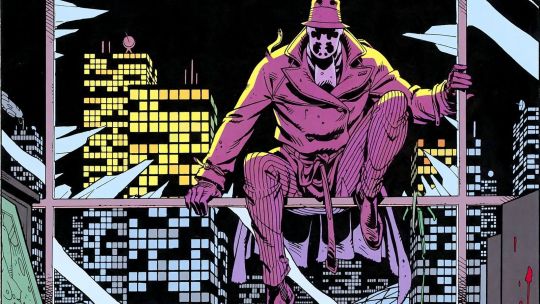
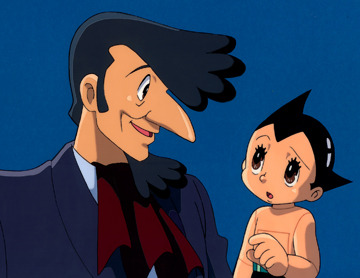

I revisit Evangelion more often than I revisit Watchmen, though Moore and Anno have made it difficult to follow their creative output. Moore’s return to the independent comics publishers to pursue more explicitly sexual, violent, and sexually violent works like Lost Girls, Neonomicon, The Courtyard, and Providence, while Anno’s attempt to retell Evangelion in a new context through the Rebuild of Evangelion movies has stalled with increasingly long delays. Evangelion 1.0: You Are (Not) Alone was released in Japan in 2007, while Evangelion 2.0: You Can (Not) Advance was released in 2009. Evangelion 3.0: You Can (Not) Redo was released in 2012, while production on the final Rebuild of Evangelion film has only barely begun.
Part of the delay in the Rebuild of Evangelion project was Anno’s and Shinji Higuchi’s involvement in Shin Godzilla, which is also known as Godzilla: Resurgence. Anno was contacted to direct Shin Godzilla after falling into depression after completing Evangelion 3.0. Principal photography for Shin Godzilla began in 2015, and the film was released in 2016. It re-positioned Godzilla as a creepy, scary monster, a force of man-made disaster that would serve as allegory for the Japanese triple disaster of the Tohoku earthquake and the subsequent tsunami and the Fukushima Daiichi nuclear disaster of March 2011. (American films will allude to traumatic events in fiction, but more often than not American films will outright try to recreate the traumatic events. You might see Batman vs. Superman: Dawn of Justice, for example, reference the September 11, 2001 terrorist attacks on the World Trade Center, but you’re more likely to see movies that try to recreate that historical event, thereby compressing and distorting history. There’s actually more intellectual honesty in allegorical approach than trying to make a film based on a true story.)


vs.
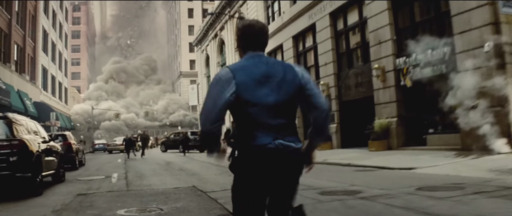


Furthermore, while Anno and Higuchi criticized the Japanese government’s slow response to the disasters of March 2011 through the way actions to counteract Godzilla’s advance would have to flow from the theatre of action up to sub-commanders to deputy ministers to cabinet ministers to the prime minister, who would make a decision that would have to then travel down the same of communication chain before it was communicated, Anno and Higuchi showed great optimism and faith in Japanese infrastructure. Politicians who could be interpreted as weak or concerned about preserving their reputation could be reinterpreted as figures who are willing to give up power so the country could have a fresh start in the aftermath of Godzilla’s cataclysmic visit, figures who are willing to sacrifice their honor for the country’s sake, or figures who are willing to sacrifice their reputations so they could give citizens the best information they had at the time. There’s a lot of moving from one conference room to another that might seem unnecessary to the impatient viewer, but the conversations in those conference rooms are what lead to solutions.
It helps that Anno and Higuchi find sharp angles to film what could have been devastatingly dull conversations in these conference rooms.



Finding these new angles to show men and women working together to solve the Godzilla problem places the emphasis on their humanity and professionalism. Godzilla will not be defeated by sheer force of Japanese or American arms. While Anno and Higuchi uses gorgeous compositions to show the futile attacks on Godzilla by the Japanese Self-Defense Force, they also show the futility of these attacks in widescreen, captivating shots that also emphasize Godzilla’s magnitude.


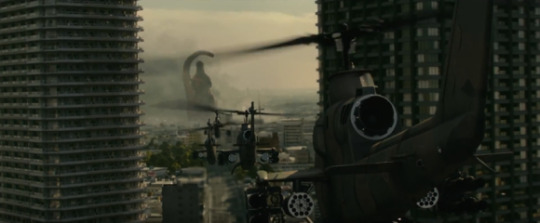



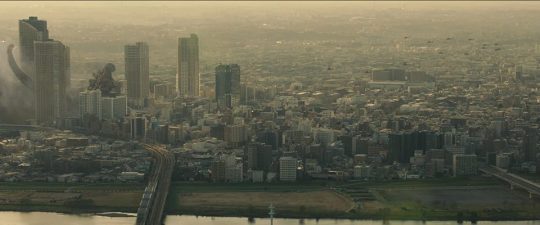
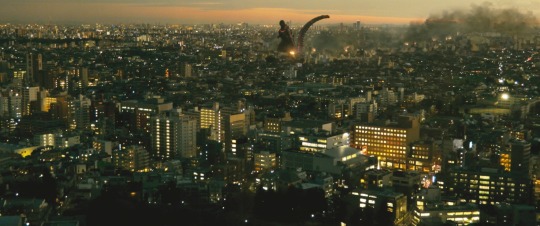

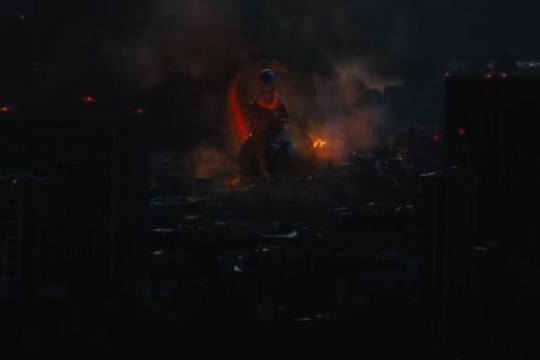
Instead, Godzilla can only be defeated when Japanese industrial acumen, business connections, and American arms are combined to form a strategy that requires self-sacrifice and precise timing, hallmarks of Japanese industrial culture. The hope for Japan won’t be found outside the country. Conventional arms cannot defeat Godzilla. Outlandish non-conventional weapons, like MASER cannons or Mechagodzillas, aren’t feasible. Instead, the hope for survival and the future can be found in Japanese systems like its trains and its industries. It’s subtly nationalist in a way that matches resurgent Japanese nationalism under Prime Minister Shinzo Abe’s regime.
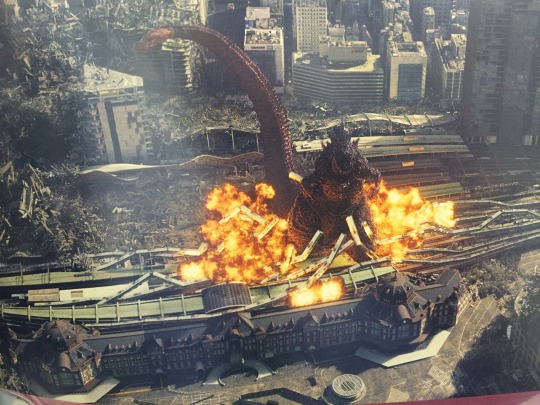
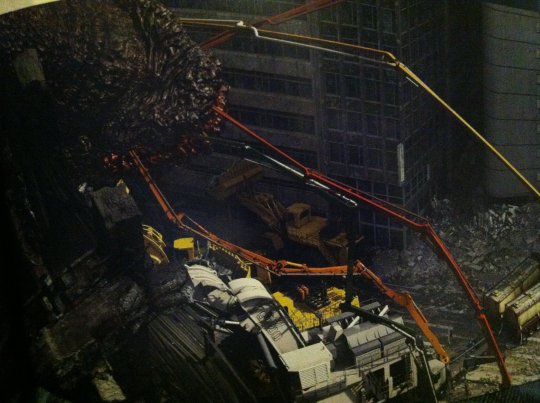
Of course, none of this would have been possible if a team of Japanese scientists and officials who do not conform to their institutions had not been grouped together to find a solution. There’s a power to the bureaucracy, the film argues, in coordinating responses among different agencies and in bringing together the outsiders and non-conformists, and there is a role for the “lone-wolves, nerds, troublemakers, outcasts, academic heretics, and general pains in the bureaucracy” in any organization.
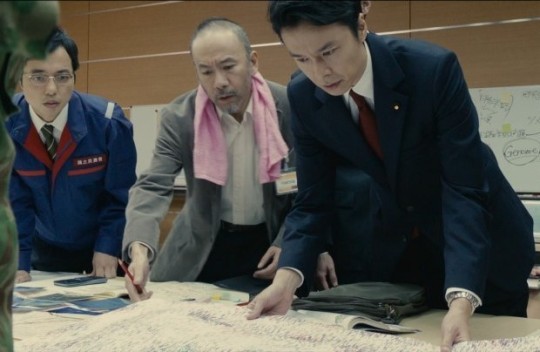
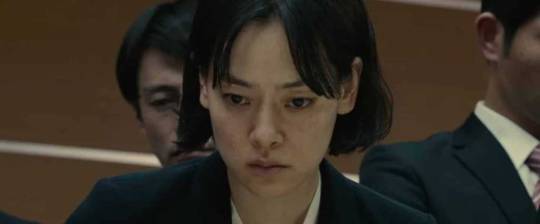
The film is similarly conflicted about Japan’s relationship with the United States. American officials are almost always depicted as faceless voices that demand from afar, sending a half-Japanese liaison, Satomi Ishihara’s Kayoko Ann Patterson, to connect with the Japanese crisis team. Ultimately, Patterson sides with the Japanese government at her own risk at a critical moment, prompting the idea that even those who are of Japanese descent living outside Japan are crucial to Japan’s future. Japanese officials are frustrated by American interference in their affairs; the American government goes so far as to propose using a thermonuclear weapon on Godzilla, which horrifies every Japanese official and even Patterson. In the end, the film taps into the renewed sense of Japanese nationalism by showing that Japanese officials can only move forward to solve the Godzilla problem by going their own way, defying the American attempt to take charge, and solving their problem their way.
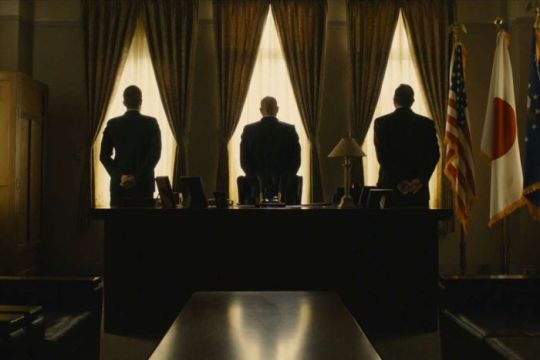
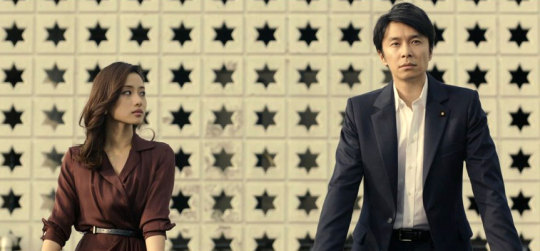
(There’s probably an essay to be written about how the film treats its three principal female characters: Kayoko Ann Patterson, Mikako Ichikawa’s Deputy Director of Nature Conservation Bureau Hiromi Ogashira, and Kimiko Yo’s Defense Minister Reiko Hanamori. Hiromi and Patterson are probably around the same age, and they’re equally outsiders. Patterson is the American half-Japanese liaison, while Hiromi is outspoken and somewhat socially awkward. Patterson is much more conscious about her physical appearance, while Hiromi wears no make-up at all. Reiko stands apart from them both; older than both other women, Reiko is a senior official in the Japanese cabinet and the military’s voice for the Prime Minister.)
Anno, Higuchi, and composer Shiro Sagisu also layer in plenty of homages for Evangelion fans. Based on my impressions, I’ve found these callbacks:
The use of the track “Decisive Battle” from the Evangelion soundtrack to spice up scenes of men and women working in conference rooms
The way the film places a visual emphasis on Japanese trains
The way Anno and Higuchi framed their shots of tanks, aircraft, and artillery pieces bombarded Godzilla in the same ways that they attacked Angels throughout Evangelion
The way they focused on Godzilla’s eyes to show its monstrosity in the same way they focused on Eva-01′s eyes to show its near-humanity
The way the final shot echoed the Failures of Infinity in the Evangelion: 3.0+1.0 teaser trailer at the end of Evangelion 3.33
The way the lights turned out in the underground shelter echoed the way the lights went out during an Angel attack
The way Godzilla attacked all around him echoed the way Ramiel defended itself in Evangelion 2.0
The way Godzilla’s blood plopped to the ground echoed the way various Angels’ blood would fall after they were killed
The way military officials were framed when they released their attacks on Godzilla/the Angels were ineffective
The Japanese Twitter user named “bakashinji” who had an Asuka avatar.

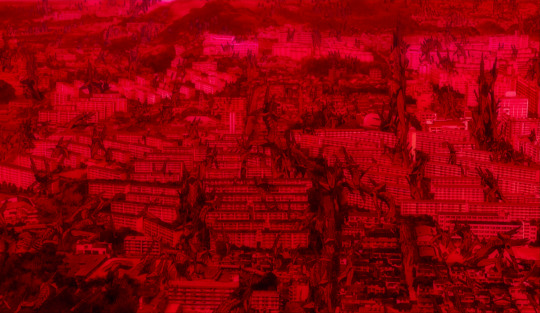
While the film is dialogue heavy, it never feels slow. And it’s a surprisingly funny film, from Godzilla’s googly eyes in its first appearances to the way that an official’s title becomes a visual gag in subtitles because it takes up almost half the screen.

It was everything that I had hoped for from a film by Anno and Higuchi: satirical, strangely hopeful, dynamically shot, wonderfully scored. In other words,
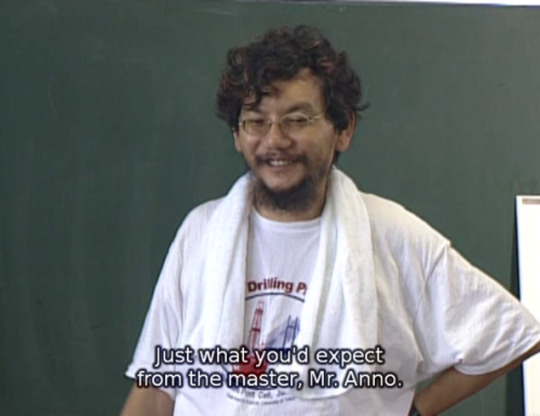
#shin godzilla#hideaki anno#shinji higuchi#shiro sagisu#godzilla#kaiju#hiroki hasegawa#yutaka takenouchi#ishihara satomi
182 notes
·
View notes
Text

Unit 02 is a red evangelion unit piloted by Asuka Langley Soryu, and contains the soul of her dead mother, Kyoto Zeppelin Soryu. it first appears in neon genesis evangelion in episode 8 as it's being transported to Japan before being attacked by Gaghiel. the eva is a fairly effective weapon when controlled by Asuka, and is shown to win many battles. however, after the losses against Bardiel and Zeruel, as well as the mental turmoil that it and Asuka experience from Arael, the sync rate between Asuka and unit 02 drops so low that unit 02 is incapable of movement. Kaworu Nagisa is brought in as a potential replacement, but he then uses unit 02 to enter central dogma (only to find that Lilith is stored there and not Adam) before he is killed. originally, I was gonna include the EoE fight as part of unit 02 non berserk, but people voted that unit 02 is technically is a sort of berserk state during that fight.
https://wiki.evageeks.org/Evangelion_Unit-02

Kaworu Nagisa is very similar to Rei, in the fact that he is a seed of life inhabiting a human body. while Rei is from Lilith, Kaworu is from Adam. despite his human form, he doesn't consider himself to be human. he also frequently refers to humans as "Lilin". he was secretly sent by SEELE to reach Adam and cause the third impact, but NERV was told that he would be a replacement pilot for unit 02. he immediately achieved perfect sync rates during his first test. despite being sent to destroy humanity, he takes an interest in them and their loneliness, especially Shinji. Kaworu takes great interest in Shinji, which initially makes Shinji uncomfortable as he has trouble trusting or emotionally connecting with people, but eventually they become close. later Kaworu takes control of unit 02 and descends to central dogma containing the body of Lilith. as he fights with Shinji, Shinji is emotional distraught and says that Kaworu betrayed him just as Gendo had. Kaworu then begs for Shinji to kill him, which he does reluctantly. in end of evangelion, he is part of the massive Rei/Lilith/Adam being, and appears to help calm Shinji and bring down his AT field.
in the rebuilds, he appears on the moon during the construction of Eva-06 before becoming it's pilot in 2.0. he, inside 06, stops Eva-01 from activating the third impact. post time skip, he plays a much larger role. as Shinji reaches the now nearly destroyed NERV hq, he meets Kaworu he teaches him to play the piano, and the two become very close. Kaworu shows him the ruins of the near third impact, and Shinji is distraught saying that he only wanted to save Rei, but Kaworu says that humanity does not see it that way. Kaworu tells him that they can save the world again by pulling the spears of longinus and cassius from Mark.06. he then takes Shinji's choker and claims that he will bare the wait of Shinji's punishment. as they descend and during the battle, Kaworu notices that something is wrong, and begs Shinji not to pull the spears. but Shinji doesn't listen and the twelfth angel is released. because of this, Kaworu becomes the thirteen angel. unit 13 then begins to awaken as the forth impact starts. Kaworu apologizes to Shinji and says that it was his own fault. he says that they will meet again before the choker explodes and decapitates him. although Mari manages to eject Shinji, he is absolutely fucking traumatized. during the additional impact in 3.0+1.0, Kaworu appears as a vision and explains that he has written Shinji's name in the book of life, which allows them to meet in all cycles after every time the universe is reset. after the would is rebuilt again without evangelions ever existing, Kaworu is seen as an adult, alongside the other children now also adults.
https://wiki.evageeks.org/Kaworu_Nagisa
19 notes
·
View notes
Text
Mark.04B is a eva that is fought by unit 02 at the beginning of Evangelion 3.0. it appears as a box before rapidly unfolding into a large ribbon that shoots light and energy attacks at unit 02, one of which hits Asuka's corrupted eye through her eva. 04B is destroyed by an energy blast from unit 01.
https://wiki.evageeks.org/Evangelion_Mark.04

Kaworu is Shinji's boyfriend.
okay but actually, Kaworu Nagisa is very similar to Rei, in the fact that he is a seed of life inhabiting a human body. while Rei is from Lilith, Kaworu is from Adam. despite his human form, he doesn't consider himself to be human. he also frequently refers to humans as "Lilin". he was secretly sent by SEELE to reach Adam and cause the third impact, but NERV was told that he would be a replacement pilot for unit 02. he immediately achieved perfect sync rates during his first test. despite being sent to destroy humanity, he takes an interest in them and their loneliness, especially Shinji. Kaworu takes great interest in Shinji, which initially makes Shinji uncomfortable as he has trouble trusting or emotionally connecting with people, but eventually they become close. later Kaworu takes control of unit 02 and descends to central dogma containing the body of Lilith. as he fights with Shinji, Shinji is emotional distraught and says that Kaworu betrayed him just as Gendo had. Kaworu then begs for Shinji to kill him, which he does reluctantly. in end of evangelion, he is part of the massive Rei/Lilith/Adam being, and appears to help calm Shinji and bring down his AT field.
in the rebuilds, he appears on the moon during the construction of Eva-06 before becoming it's pilot in 2.0. he, inside 06, stops Eva-01 from activating the third impact. post time skip, he plays a much larger role. as Shinji reaches the now nearly destroyed NERV hq, he meets Kaworu he teaches him to play the piano, and the two become very close. Kaworu shows him the ruins of the near third impact, and Shinji is distraught saying that he only wanted to save Rei, but Kaworu says that humanity does not see it that way. Kaworu tells him that they can save the world again by pulling the spears of longinus and cassius from Mark.06. he then takes Shinji's choker and claims that he will bare the wait of Shinji's punishment. as they descend and during the battle, Kaworu notices that something is wrong, and begs Shinji not to pull the spears. but Shinji doesn't listen and the twelfth angel is released. because of this, Kaworu becomes the thirteen angel. unit 13 then begins to awaken as the forth impact starts. Kaworu apologizes to Shinji and says that it was his own fault. he says that they will meet again before the choker explodes and decapitates him. although Mari manages to eject Shinji, he is absolutely fucking traumatized. during the additional impact in 3.0+1.0, Kaworu appears as a vision and explains that he has written Shinji's name in the book of life, which allows them to meet in all cycles after every time the universe is reset. after the would is rebuilt again without evangelions ever existing, Kaworu is seen as an adult, alongside the other children now also adults.
holy fuck that's the longest description I've written by a long shot
https://wiki.evageeks.org/Kaworu_Nagisa

8 notes
·
View notes